Why mustard is a garden must-have plus 6 ideas for cooking with mustard
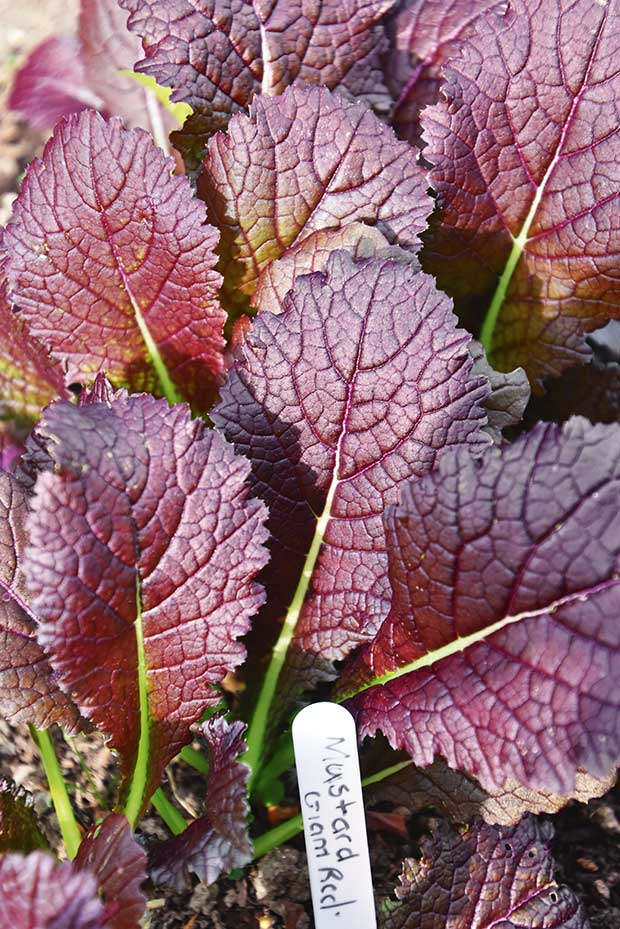
Young plants of Mustard Giant Red.
Mustards are the most feared of leafy greens, but they’re now essential in Jenny Somervell’s kitchen.
Words and images: Jenny Somervell
Why I chose rush hour to drive from east to west Christchurch to buy mustard greens, I can’t imagine. It was 25 frazzled, traffic-clogged minutes and it was with minutes to spare that I zoomed into the Asian grocery shop and scanned the vege shelves for the magic ingredient I was after.
Half the vegetables were not named, as regulars queuing at the counter must know their vegetables by sight. Not me. Pak choi looked familiar but nothing else – I only knew what mustard should taste like.
READ MORE: How to grow mustard greens
I spotted bunches of large, rough-looking, slightly serrated leaves, which bore a resemblance to the baby mustards in my garden. Were they mustard leaves? Everyone in the store was flat out so I sneaked a piece of tattered leaf off the side and bit into it.
Definitely mustard and it had a kick! Ten minutes later, twiddling thumbs at a long traffic light, the aftertaste was still reverberating around my mouth, bright green, fresh, and mustardy. No chance of falling asleep on the long road home.
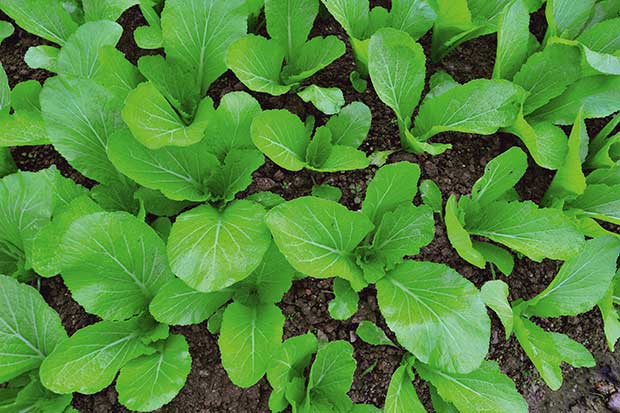
FEARING THE MUSTARD
Why has it has taken us this long to wake up to mustard’s possibilities? One website I found quoted a survey saying mustards (varieties of Brassica juncea) were the most feared vegetable. I was both excited and apprehensive about what the cook could do with them. I was aware it could go badly wrong.
It seems the key to success is just the right amount of cooking, combined with the right flavours that enhance the taste and counteract the pungency.
Mustards go well with stronger flavours such as duck, salmon, bacon, ham, sesame oil, ginger, cumin, garlic, onion, tomato, curry, soy sauce, prosciutto, toasted nuts and sharp cheeses.
In Asian cooking, tamarind, sake, rice wine vinegar, ginger and chillies are common complements. Including olive oil and nuts helps to make the rich supply of antioxidants and vitamins in mustards more easily absorbed.
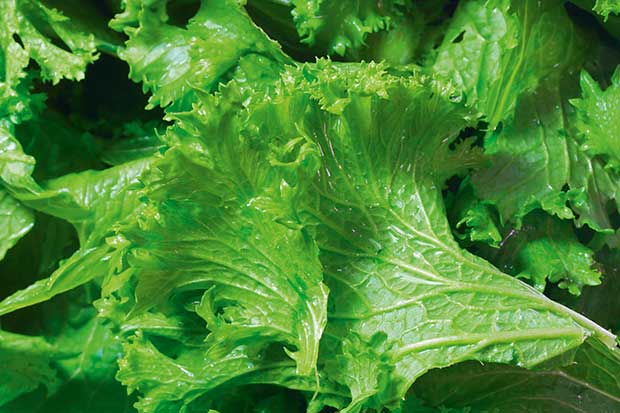
MUSTARDS FOR YOUR HEALTH
Cooking with mustards is good for your health. They have extremely high levels of the immune-boosting vitamins A and C, are low in calories, high in fibre and vitamin K, and have good levels of essential minerals including calcium, magnesium, zinc, selenium and manganese.
They are also high in chlorophyll, which is believed to pull environmental toxins from the blood, and neutralise heavy metals, chemicals and pesticides in the body. Interestingly, mustard plants have been used effectively to remove heavy metals, such as cadmium, from soils.
The rich supply of flavonoids in mustards (indoles, sulforaphane, carotenes, lutein and zeo-xanthin) may reduce cancer risk. Indoles in particular, have been shown to inhibit cancer cell growth. There is also research interest in the capacity of mustard to increase bile production and decrease ‘bad cholesterol.’
Perhaps the Chinese were aware of some of mustard’s health benefits, traditionally drinking mustard as a spring tonic.
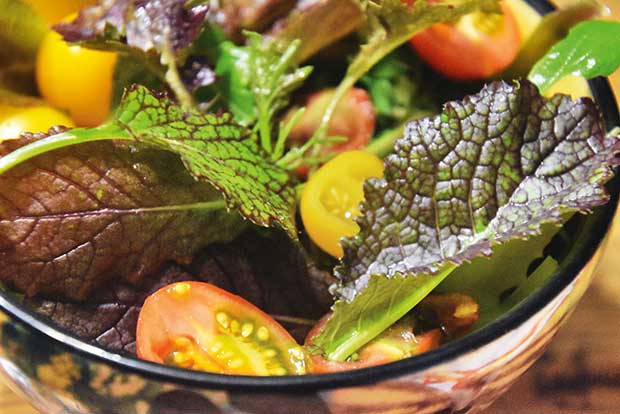
Baby mustard greens, grown by Jenny.
HOT OR NOT
Fresh mustard leaves are deep green and broad with a flat surface, and edges which may be may be toothed, frilly or lacy, depending on the variety. Generally mustard leaves are rougher than other Oriental brassicas and more pungent.
The degree of pepperiness varies enormously with variety, age of leaf, growing conditions and even part of the plant. Stems can be mild and leaves hot, and vice versa. Small leaves are milder and more suited for salads than larger leaves, although these can be shredded to add extra ‘zing.’
I sprinkle a few mustards in my mesclun mixes in autumn and spring to liven up our salads and add interesting textures and colours.
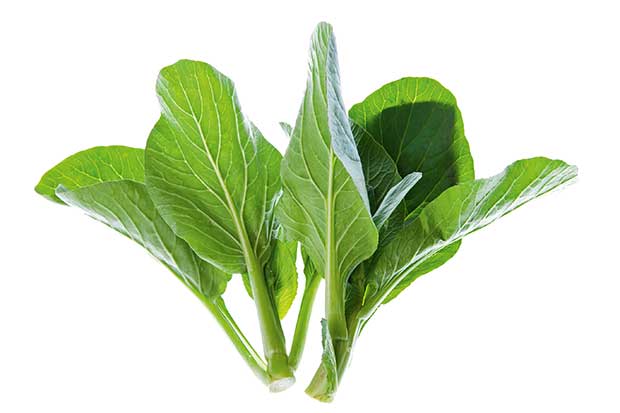
Textures range from bubbly, savoyed types to the delicately fringed, curly types, of which my favourite is one called Lime Streaks. We grow this little beauty in our mesclun mix year-round for its golden, lacy leaves and mild, peppery bite.
It is heat-tolerant and more bolt-resistant for summer use, with a pleasant, mild mustard flavour. It also regrows faster than other varieties, which are quite slow.
Having said that, it was the colour, rather than the flavour of mustards, that first attracted me. I was indulging my dangerous hobby of browsing seed catalogues and spotted the vibrant purple and maroon red leaves.
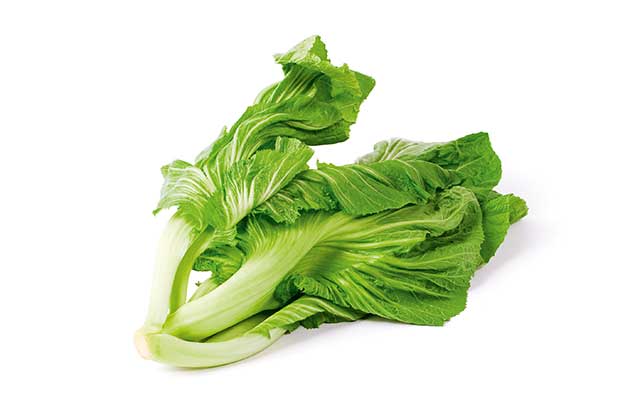
They shouted “Plant me! I’ll cheer up your winter garden!” and indeed they did, until four days of gale force nor’westers attempted to pulverise them into the soil. They handled it better than the kales but still came out a little seared around the edges.
Discovering that mustards make delicious, zippy dishes was an unexpected bonus.
If your plants failed, or you didn’t get any into your garden in autumn, you can always take a trip to an Asian vege store. Give yourself plenty of time though in case you need help identifying them. There’s a bit that can get lost in translation.
5 HOT IDEAS FOR MUSTARD GREENS
1. Use only fresh, crisp, dark green leaves. Store refrigerated, and use within three days.
2. Grow mustard micro greens to just one or two pairs of leaves and add to salads for a mild, mustardy zip without being too hot. Balance with milder flavours such as lettuce, corn salad, pea shoots and young spinach or mizuna. Great with a lemony, vinaigrette dressing.
3. Larger more pungent leaves are best lightly cooked – toss in a wok, or blanch with boiled water or steam to ‘tame their bitterness’, while retaining the bright colour and texture. Use alone or mix with other milder greens such as spinach, komatsuna, mizuna etc. Dress with olive oil, a sprinkle of sea salt and a squeeze of lemon juice.
4. Substitute for chard or spinach in a quiche or wrap around salmon steaks before baking.
5. Coloured leaves make a great garnish.
WARNINGS:
◊ Anyone taking blood thinners or anti-coagulants such as warfarin should avoid mustards as they increase blood Vitamin K concentration.
◊ Those with known urinary tract stones should avoid eating mustards (and other members of the Brassica family) due to their oxalic acid content.
◊ Avoid reheating mustard greens as nitrates can be converted to nitrites and nitrosamines.
RECIPE: SAUTÉED MUSTARD GREENS AND CHICKEN
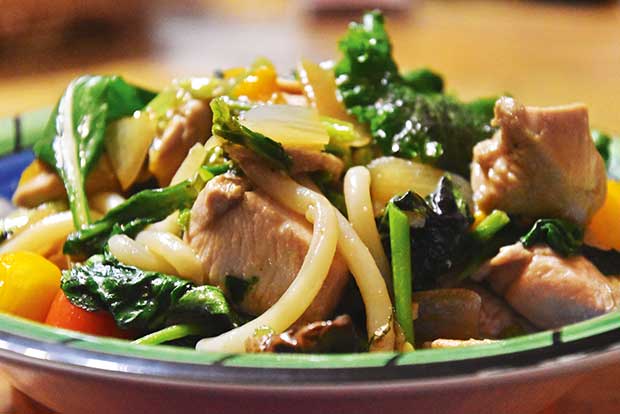
For this recipe, you want about a 2-litre ice cream container of loosely packed leaves once removed from the stalks.
INGREDIENTS
One large bunch of mustard or the equivalent in a variety of mustards, including stalks
3 chicken breasts
1 large onion
2-3 half capsicums of different colours
1 knob of root ginger, about 3-4cm long
1 tbsp oil
4-6 cloves garlic
2 packets udon noodles
10-12 cherry tomatoes
1 tsp salt
fresh ground black pepper
1 tbsp honey
METHOD
Remove the roots from the mustard and discard. Cut the leaves from the stalks, removing the thick stalk from the centre of the leaves as well. Chop the stalks into 1-2cm lengths.
Slice the leaves crossways into strips 2cm wide. If the leaves are particularly large then slice once down the centre as well. Wash the leaves and leave to drain in a colander. Cut the chicken breasts into 2-3cm cubes.
Peel and chop the onion into chunks, deseed the capsicums and chop into chunks. Peel and shred the ginger. Peel and finely chop or crush the garlic.
Heat the oil in a large frying pan or wok. Add the onion, garlic and ginger and sauté for 2-3 minutes. Add the chopped chicken and capsicums and sauté until nearly cooked, about 5-10 minutes.
Meanwhile, bring a pot of salted water to the boil, then add the udon noodles and stir until separated. Add the tomatoes, salt, pepper, honey and mustard stalks and sauté while stirring for a further 1-2 minutes.
Drain the noodles and add together with the mustard leaves and sauté, stirring for about a minute, until the leaves are hot but not wilted. Remove from the heat and serve. Delicious!
READ MORE
Love this story? Subscribe now!
 This article first appeared in NZ Lifestyle Block Magazine.
This article first appeared in NZ Lifestyle Block Magazine.
